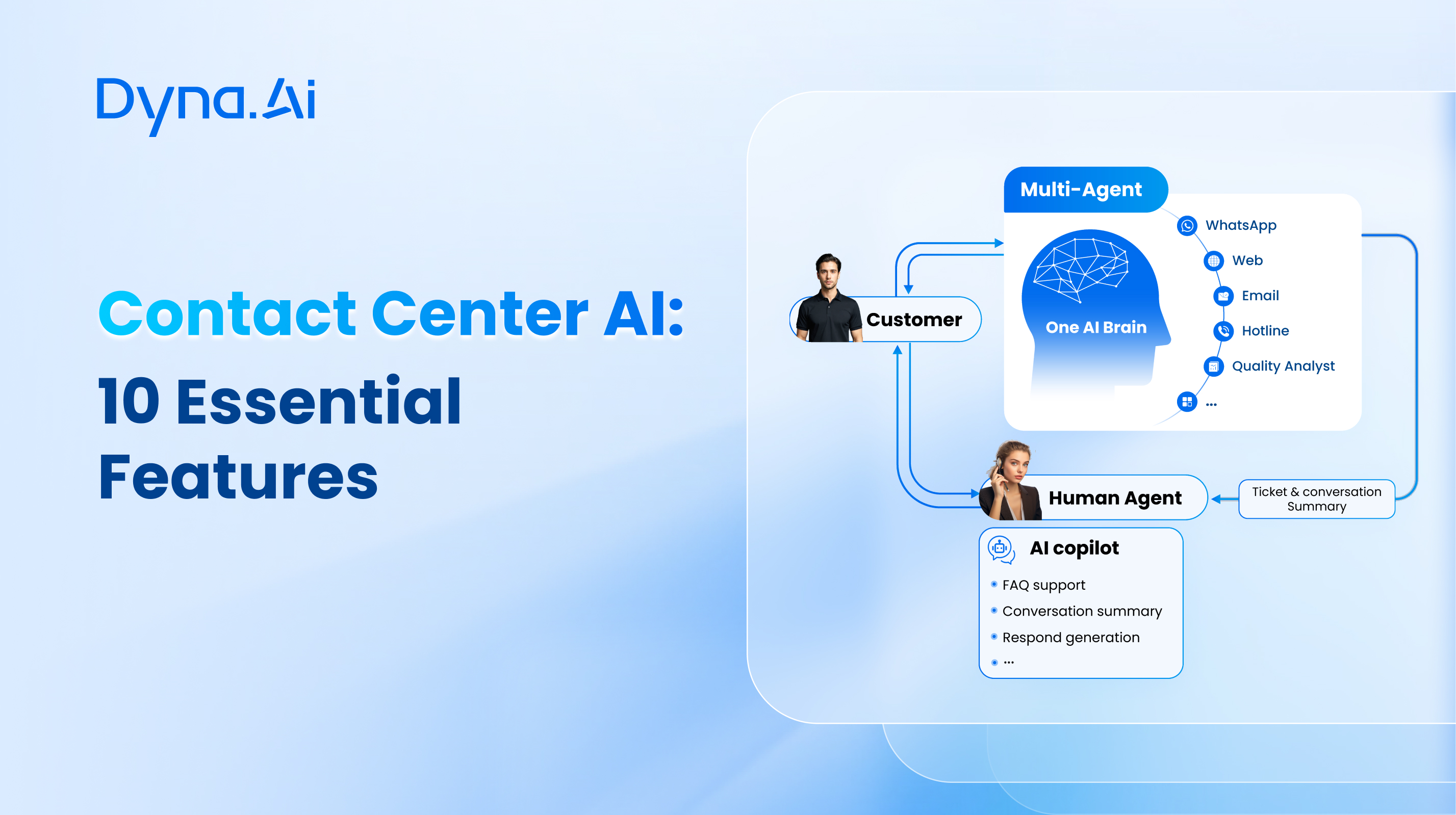In today's fast-paced world, customer expectations are higher than ever. More and more customers prefer using phone calls or digital channels to resolve their issues quickly, demanding faster response times and immediate solutions. However, human agents in traditional contact centers are often overwhelmed by the sheer volume of inquiries, leading to longer wait times, burnout, and decreased efficiency. This widening gap between rising customer expectations and the capacity of human agents creates significant challenges for businesses. The solution to this dilemma lies in implementing AI Contact Centers, which bridge this gap by using artificial intelligence to handle routine tasks, optimize workflows, and provide faster, more personalized service at scale.
In this article, we will explain what an AI Contact Center is, how it operates, the functions it offers to businesses and customers.
1. What is an AI Contact Center?
An AI Contact Center is an advanced customer service platform that leverages artificial intelligence to manage and automate customer interactions across multiple communication channels, including voice, chat, email, and social media. While some companies may still rely on Natural Language Processing (NLP), Dyna.Ai goes further by using Large Language Models (LLMs) to provide a more sophisticated understanding of customer inquiries. These systems also integrate other technologies like speech recognition, machine learning (ML), and robotic process automation (RPA), enabling them to understand complex queries, generate relevant responses, and automate repetitive tasks.
Unlike traditional contact centers that rely solely on human agents, an AI Contact Center acts as a tool to assist human agents. It’s not designed to replace humans but to enhance their efficiency by handling routine, repetitive tasks such as answering frequently asked questions, processing basic requests (e.g., order status checks, account information updates, or appointment scheduling), and providing instant responses. This allows human agents to focus on more complex, nuanced, or emotionally charged interactions that require empathy and expertise.
2. How Does an AI Contact Center Work?
An AI Contact Center operates by leveraging a combination of Conversational AI and Generative AI, allowing it to efficiently handle customer interactions and provide seamless service. Here's a breakdown of how these technologies work together to improve customer experience:
- Conversational AI: Dyna.Ai serves as the front-end interface that interacts directly with customers, leveraging the power of Large Language Models (LLMs) to understand and interpret their queries This allows the system to engage in meaningful conversations, whether through voice or text, and generate relevant responses. Conversational AI can handle routine inquiries, such as order status checks or FAQs, autonomously. For more complex issues, it escalates the conversation to a human agent.
- Generative AI: While Conversational AI focuses on dialogue, Generative AI works in the background to produce the content and solutions required to address customer needs. By drawing from large datasets, including customer history and real-time interactions, Generative AI formulates personalized responses and suggestions. This helps create tailored solutions, enhancing the experience for both customers and agents.
- Integration with Business Systems: One of the critical capabilities of an AI Contact Center is its ability to integrate with a company's backend systems, such as Customer Relationship Management (CRM) platforms, billing systems, and order management tools. This integration enables the AI to access customer data and history in real-time, providing more accurate, context-aware responses. It also ensures that complex queries can be routed to the appropriate department or human agent seamlessly.
- Machine Learning and Continuous Improvement: Through Large Language Model (LLM), Dyna.Ai AI Contact Centers continuously improve over time. By analyzing past interactions, the system learns from previous responses, improving its understanding of customer needs and optimizing its future responses. This ongoing learning process ensures that the AI becomes more effective and efficient at resolving customer issues.
3. Core Functions of an AI Contact Center
An AI Contact Center comes equipped with a range of powerful features that enhance customer service and streamline operations. Each business may implement AI differently based on their specific needs. Some of the key functions include:
- Customer Communication: AI Contact Center uses chatbots and virtual assistants to handle routine tasks such as answering common inquiries (e.g., order tracking, account balance checks, and appointment scheduling). For more complex queries, virtual assistants simulate human-like conversations and assist with multi-turn interactions.
- Voice Interaction: With speech recognition and voice bots, AI systems can process voice calls efficiently. These technologies allow the system to understand customer intent, respond with appropriate solutions, or route the call to human agents when necessary.
- Omni-Channel Integration: AI Contact Center provides omni-channel support, connecting multiple communication platforms-such as phone calls, emails, live chat, and social media—into a unified system. This ensures a seamless customer experience across different channels, with continuity in conversations.
- Sentiment Analysis: Powered by AI-driven sentiment analysis, these systems can detect emotional cues in customer interactions. This enables businesses to prioritize urgent cases and address customer concerns based on the emotional tone of the conversation.
- Data Insights: AI systems gather and analyze customer interaction data, generating actionable insights. These insights help businesses refine their service strategies, personalize interactions, and identify trends and pain points, ultimately improving service delivery.
Conclusion: The Future of AI Contact Centers
An AI Contact Center represents a significant leap forward in transforming customer service by combining automation and intelligence to meet modern expectations. As AI continues to evolve, these systems will only become more intuitive, seamless, and efficient, providing deeper insights, more personalized interactions, and increasingly complex solutions. The future of customer service lies in the collaboration between human expertise and AI-driven support, promising a more agile, responsive, and customer-centric experience for businesses and consumers alike.
Ready to transform? Discover Dyna.Ai's multimodal solutions today!
-Explore how Dyna.Ai's Agent Studio, VoiceGPT, and AvatarGPT can revolutionize your business.
-Book a demo to see Dyna.Ai in action.
